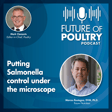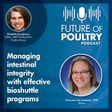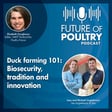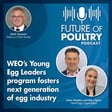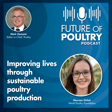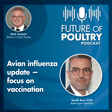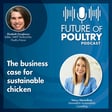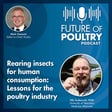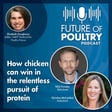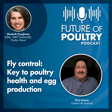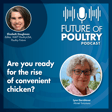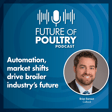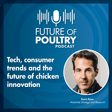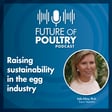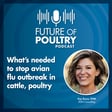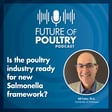Become a Creator today!Start creating today - Share your story with the world!
Start for free
00:00:00
00:00:01

What's next for poultry health?
The global poultry industry is adjusting to using fewer antibiotics, taking many laying hens out of cages, and in some cases, providing outdoor access for flocks while at the same time striving for continuous improvements in bird health and welfare.
Join a panel of experts for a discussion of the promising technologies being researched and developed to improve the health and welfare of broilers, turkeys and layers.
Panelists:
- Joshua Deines, Ph.D., technical services device lead, Zoetis
- William Herring, Ph.D., vice president, research and development, Cobb-Vantress
- Theresia Lavergne, Ph.D., senior technical service manager, Natural Biologics
- Dr. Linnea Tracy, veterinary services manager, Ceva Animal Health
Moderated by Terrence O'Keefe, content director, WATT Global Media
This episode is sponsored by Ceva Animal Health, Cobb-Vantress, Natural Biologics and Zoetis.
Transcript
Introduction and Panel Overview
00:00:00
Speaker
Hello and welcome to the Future of Poultry podcast series.
00:00:13
Speaker
My name is Terrence O'Keefe, and I'm the Content Director for Watt Global Media. I recently had the opportunity to moderate a panel discussion on the future of poultry health at IPPE 2024. This discussion was sponsored by SEVA, Cobb Vantress, Natural Biologics, Target, and Zoetis.
00:00:37
Speaker
Our panelists are Dr. Joshua Dines, Technical Service Device Lead for Zoetis, Dr. William Herring, Vice President, Research and Development for Cobb Vantress, Dr. Theresa Laverne, Senior Technical Service Manager, Natural Biologics, and Dr. Linnea Tracy, Veterinary Services Manager for SEVA Animal Health.
00:01:06
Speaker
Yeah, there are several factors that impact the health and wellness of broilers, turkeys, and layers under our care.
Genomic Selection in Poultry Health
00:01:14
Speaker
I've got a few questions to get the things rolling. I'd like to ask Dr. Herring, William. Genomic selection's been used in poultry breeding for over a decade. Have we seen improvements in poultry health outcomes in the field that can be attributed to genomic selection?
00:01:33
Speaker
Okay, so we'll get it started. Interesting question. So maybe just start with a little bit of a background on what genomic selection is just to get us all on the same plane. So genomic selection is still relatively new across agricultural genetics. It'd be used across crops, livestock, and poultry really over the last 10 to 15 years.
00:01:57
Speaker
And as I think about it, previous to genomic selection, all of those areas basically just used documented pedigrees and things we could measure in broilers or cattle, dairy, whatever, to come up with a prediction approach on how we select each of the species. When genomic selection came along, really what it did was just honestly enhance our accuracy of predicting the future.
00:02:26
Speaker
What it does is it trains on those other data that I referenced, and then along with the genotypes gives us a better idea, just a little bit more accurate to quite a bit more accurate in terms of how we select or cull in the genetic selection process. And it's really been, and it's well documented across all those species I mentioned in terms of how it's impacted things. And broilers I don't think are any exception.
00:02:54
Speaker
Really when it comes to health and the health associated traits, it's even much more powerful in that area because first of all, those traits are honestly fairly difficult to measure. Think about a big bucket trait like mortality. There's a whole distribution of underlying causes.
00:03:14
Speaker
And honestly, they're difficult to measure well and document well. As a geneticist, I always tell people that if I can measure something really well, I can change it. But health is one of those and underlying livability.
00:03:32
Speaker
Now, with all of that said, if I can do that, well, genomics then augmented with the pedigree and phenotypes that we measure really can be terribly and positively impactful. There are other trait examples as well, but livability is one that it can definitely impact. How has it changed things?
00:03:57
Speaker
You know, I think some of the underlying traits like leg health, joint health, things that we do measure at the pedigree or nucleus level, it's been very helpful in those we've looked within our own systems and it's very positive. We still have a ways to go because there is a whole profile of other traits that are important to our customers, but it's been a value add when it comes to changing the bird.
00:04:26
Speaker
Thanks.
Gut Microbiome Research and Challenges
00:04:28
Speaker
Continuing on with the whole genome sequencing area, Teresa, on the scale of crawl, walk, run, where do you think we are in terms of understanding and effectively managing the gut microbiome? I know we've had tremendous advances where we can actually figure out what's in there.
00:04:50
Speaker
and we weren't able to before. So where are we and how are we progressing? Exactly. We are definitely not running. We definitely have been crawling and I believe we're starting to stand up and walk just a little bit at times.
00:05:05
Speaker
But definitely in the big scheme of life, this is still a very, very new science, right? Since the 1990s, we've been talking about the microbiome in humans and animals. And so it's really still a very new science. We learned that there's a lot to learn about it. Some of the things we do know is it's very dynamic, right? Definitely not static, our gut microbiome.
00:05:33
Speaker
It can be changed very easily and very quickly. There's so many different production scenarios, health status scenarios, you know, that we might use in our research to change the microbiome, and then we add to that the feedstuffs, just even feed phase changes throughout poultry production, change the microbiome.
00:05:58
Speaker
whatever happens or what we have in the environment changes the microbiome. So we just learned that there's just so many fluctuations in it and kind of have to eventually narrow down on production systems and what's in the environment to kind of help make things stable and have the best, I guess, production related to the microbiome.
00:06:25
Speaker
And as you referred to, and again, me saying it's a fairly new science, part of that is because a lot of these biomarkers or bacteria there in the gut are not culturable. So we have needed the DNA sequencing technology to even find them. And we've learned that there are more of those microbial or bacteria cells in the gut than there are
00:06:52
Speaker
cells, human cells or animal cells within the body. So it's huge. And you have both positive and negative bacteria, how they affect health and growth. And we're still identifying what bacteria might be in the microbiome and the effect that those bacteria have, good and bad, what metabolic systems they're involved in.
00:07:18
Speaker
It's huge. There's definitely a challenge when you work in that area because things change. There's a lot to learn. But I think we're really making progress now in learning how some of our feed additives can be used to make the microbiome very favorable and gets very improved production, improved health status. Thanks.
Trends in Poultry Vaccination
00:07:40
Speaker
So, Josh.
00:07:42
Speaker
You know, making sure that each bird is vaccinated properly is important for ensuring protection for the entire flock. We've got, we've had for decades now automated systems like an ovo vaccination to ensure that each embryos vaccinating is vaccinated without requiring a lot of labor. You know, for short-lived birds like broilers, what trends do you see coming in vaccination?
00:08:07
Speaker
Yeah, definitely a lot of things are changing, always trying to be better. And some of those things you mentioned, I think are still trends today. So we should making sure that every bird is vaccinated. And that's one thing would have been able to accomplish with the Novo vaccination is fast mass application, but individualized dose so that every embryo comes out vaccinated and hopefully protected as well. So how can we apply that same concept to say spray vaccination to ensure that every bird is getting a dose? So,
00:08:35
Speaker
Some things that we see is more people are looking at the data to say, hey, we have previously been applying seven milliliters in spray vaccination, for example, but the same dose applied at 14 or 21 milliliters, just a higher volume, that same dose is getting better uptake. So how can we apply some things we've learned in Inovo to get all the birds vaccinated to spray as a trend? And then you also mentioned the labor component. And so Inovo vaccination did reduce labor significantly compared to say hand vaccinating or automated
00:09:05
Speaker
subcutaneously. So how can we continue to reduce the labor? Because that challenge has not gone away. In fact, in some circumstances, it's gotten worse in the hatchery. So continuing to reduce labor. And one trend I see in that is, how can we automate the quality control portion? We've got a lot of automated processes. We've got great technology and vaccines. But how do we quality control that in an automated fashion? So one thing we always try to accomplish
00:09:30
Speaker
through a novo, say, hey, all of our, anything that could go wrong is detectable and repairable in the field through quality control processes. However, they still take a human intervention of some kind. Somebody has to read that. Somebody has to repair it. So how can we continue to change that to make it better? And I guess the final trend I'd speak to is, you know, especially for broilers and even our long-lived birds, more of our vaccines are being administered at the hatchery than they ever were before. And that trend continues.
00:09:59
Speaker
And a lot of that is due to vectored vaccine technology. And so it's not necessarily a new technology, but it's becoming widely accepted, it's shown proven, and more people are jumping on that bandwagon. So if you're not familiar with the vectored vaccines, it's essentially one product, one cell that when administered, it provides protection against multiple diseases. And so we see that trend continuing.
Transitioning to Cage-Free Systems
00:10:21
Speaker
Great. Thanks.
00:10:23
Speaker
So Linnea, I know you've worked a lot with layers. And of course, the US layer industry is going through a transition. I think the latest stats I saw were well over 30% of the layers now are cage free in the US. And what are the health challenges that have been reemerging as we go out of the cage and onto the floor? And are there any solutions out there for it?
00:10:51
Speaker
That's a big question that we've been tackling all across the industry for years now. And it's been an ongoing conversation for both the producers and the companies coming in to help them in a technical service capacity. I think the way I would start this conversation is by saying that the things we're seeing and even the challenges we're facing with infrastructure is nothing that the industry hasn't done before. And now, as we move into a more modern age with better technology,
00:11:14
Speaker
and devices and knowledge of what we're doing. It should be, hopefully, even easier and more successful than we've ever had this before.
00:11:23
Speaker
Previously, we've had major cage-free and vice versa transitions in the industry. We're able to handle it now. It is a challenge in terms of infrastructure and capital investment and even design changes in our own production systems. But everything we're seeing now in terms of disease as well as the physical challenges are, you know, the old is new. So I hear that phrase used a lot in veterinary circles. I'm hearing it embraced a lot by the producers as well. Diseases that they haven't seen maybe in
00:11:53
Speaker
the younger generations of veterinarians have come back out. So we see things like more of cholera, more of erosipolis as we start moving these birds out of cages and even into outdoor systems that we haven't been using for years. There's a lot that we can do. It's about tapping our historical knowledge of the industry. There's also a lot of upcoming design changes in terms of
00:12:15
Speaker
administering vaccines even better than we ever have before, understanding the vaccination programs that we need, seeing and tracking the changes that are happening in the microbiota, both good and bad in these systems because everything is a little bit different.
00:12:31
Speaker
We are all capable of doing this together, so I try to preach the motto, let's not panic, let's work together. We live and work in an industry that is one of the most creative and collaborative in the United States, and that goes together, you know, pharmaceuticals.
00:12:47
Speaker
our genetics, our technical services, and the producers themselves who are in those barns every day. So there are challenges. I don't think many of them are too novel. I think we all have the solutions out there and it's about tapping the knowledge that we already have and exist that we just haven't been using for a few years.
00:13:05
Speaker
And with the longer-lived birds, we have some different challenges when it comes to vaccination, because with a broiler, 35 to 42 days sometimes on the farm, the ANOVA vaccination is fine.
Vaccination Solutions for Salmonella
00:13:21
Speaker
That takes them through to slaughter. But we don't have that luxury with some breeders and also with layers.
00:13:34
Speaker
Joshua, you know, what solutions are out there or do you think might be coming to deal with, I know with laying hands now, we have to vaccinate them multiple times for salmonella and some other things. And that involves individually handling and sticking the birds with a needle. Are there some possible ways around that where we can hopefully still do it where we get every bird
00:14:01
Speaker
but we don't need the labor and don't have to bring a crew from farm to farm. Yeah that's the challenge and something we're always working on. I think just one is the vaccine technology, finding vaccines that have longer lived immunity, earlier onset and longer lived is the first thing. So what vaccine is being administered but as you mentioned the actual administration is the challenge. So there are things like for example we have a double breast vaccinator that we're starting to employ more so we could
00:14:27
Speaker
simultaneously be administering multiple products and multiple product types in a single handling. So we may not be able to remove handling altogether, but we could remove the number of times and the stress of that single time we are handling the bird. Very good. So Teresa, you know, we talked about the the microbiome and how we were starting to learn more about
00:14:53
Speaker
Are there any common poultry disease challenges today that you think are increased knowledge of the microbiomes going to help us mitigate and maybe prevent outbreaks?
00:15:06
Speaker
Sure, definitely. And so we're talking about the gut and the microbiome and the gut. So definitely I think pathogenic diseases and even some protozoa diseases are what we're going to be really efficient at or be able to tackle, find solutions first. Because what we're feeding, and here being a nutritionist, I always like to incorporate that into what we do. It's huge, right?
00:15:31
Speaker
So, we have lots of feed additives out there, all the biotics, right, the prebiotics, probiotics, postbiotics. And we learn more about those every day. We find more strains of bacteria to use as probiotics and, of course, the postbiotics. And then we even have the phytobiotics.
00:15:53
Speaker
So, we're learning which to use, how to use them, and shift that microbiome population, obviously, to be more favorable to whether we're out-competing the negative bacteria, as well as we're really going to have to focus in on some of these commensal bacteria that are opportunistic and become pathogenic, and yes.
00:16:18
Speaker
pathogenic and even some protozoa diseases I think are going to be where we can make the most progress right now and obviously I like to do that with feed additives because they can have a huge effect on the whole microbiome population and good and bad.
00:16:35
Speaker
Well, as a follow-up, competitive exclusion was something that, you know, we've known about for decades. And, of course, the challenge in the U.S. was it had to be a defined culture if you were going to apply it to the birds in the field. So, going forward, is it going to be a combination of probiotics and prebiotics and other additives? Or, you know, so is it going to be a multi-factor solution?
00:17:02
Speaker
definitely will have to be. Being in the industry for a while, I was here when we had antibiotics, and we all know when we take that out, there has not been one replacement to do everything. So that's why we're working towards these combinations and seeing how effective they can be, the probiotics.
00:17:23
Speaker
feeding the good bacteria, the prebiotics, feeding that good bacteria, as well as learning more about different strains of bacillus or different prebiotics we can use. So, yeah, we're just having to figure out how to use them all together, what combinations might work, because there's not one tool
00:17:46
Speaker
We have to develop overall programs. Again, I go back to the feed and what we can feed, but it's not that. It's all management as well, environment within the poultry houses. It's just a huge program. We have lots of tools we can use in that program. Not one magic dust or whatever you want to call it.
AI in Poultry Breeding and Health Improvements
00:18:08
Speaker
If anyone has any questions, just raise your hand and we'll bring them in.
00:18:15
Speaker
William, I know we spoke before once at Poultry Tech about how artificial intelligence is really going to be impacting breeding programs. Could you explain a little bit about how that's going to
00:18:33
Speaker
I'll do my best. So this is actually a question that I get very frequently now from customers, from within our team, really kind of across the entire space. And I'll try and give a few different examples.
00:18:51
Speaker
At the end of the day, any part of our business that has involved data or imagery, AI offers a huge opportunity and I think at several different levels. So let me just kind of hit on a few of those. When it comes to impacting like what I
00:19:10
Speaker
myself and my team do on a daily basis, which is genetic improvement. We talked about genomics a minute ago, and when that got incorporated 10 to 15 years ago, without honestly exception across all those species I mentioned, you saw step changes in genetic improvement. The slope of genetic trend dramatically increased. I think this is really the next area that can cat can have that similar type of impact.
00:19:40
Speaker
not necessarily on the genetic prediction part, but really in how we measure things. As I said earlier, if I can measure something really well and there's some sort of underlying genetic architecture, I can change it in any direction.
00:19:58
Speaker
There's been a whole area of traits that we've had trouble with, accurately measuring. A few examples of those. Behavior is one of those. Really, how animals and poultry move are one of those. Those are things we subjectively score, and then we try and take that subjective scoring system and
00:20:24
Speaker
turn it into a metric that we can select on it and change the population based on what we think is right. So let's just take gate score for example. You can utilize video imaging technology to 24-7 record a bird and if you can do that and you can tie that to the individual identification of that bird, artificial intelligence really does a very nice job of number one mapping what we think we score
00:20:53
Speaker
to the image itself, so it removes that human variation. And then, that's step one. And when you go to step two, you can actually take on an unsupervised learning type of model, and then the data can begin to look and say, wow, this type of imaging is different than this on these specific birds. And all of a sudden, things become much more objective. It gives insights into things that the human eye couldn't pick up.
00:21:20
Speaker
That's actually a very active area of research for us. To give a little bit of a plug, last year, and we announced here this week, we did an announcement on a request for proposals called the COB Research Initiative, and that's an attempt to engage with the research community and COB fund
00:21:42
Speaker
projects that impact and welfare and animal health is one of those. So last year we funded nine different research projects. Four of those were deeply bedded with artificial intelligence. And one of those actually is utilizing cameras and gate scoring.
00:22:01
Speaker
We have one that's with male fertility, but it's all around utilization of AI. So that's number one. And there's a couple of more that I think are really important too.
00:22:16
Speaker
Really as we look kind of outside of the, somewhat outside of the genetic space, we have lots of very deep data that's publicly available around genomic sequencing, around understanding protein structures that exist, phenomics databases. I think that that's probably the ripest area that we'll see artificial intelligence have an impact on. I kind of term it as also computational biology.
00:22:46
Speaker
So if we look at whether we're going to try and manufacture, synthesize the next vaccine that's going to be more meaningful, I think interrogating the data with artificial intelligence can really provide great insights into what those targets should be.
00:23:04
Speaker
Different than how it's been done before and give you give you an example of that And I would encourage you just to go go read a couple of articles on it Google has a startup in the UK deep mind and they've done lots of really cool things but one of them is they've synthesized really simulated tens of millions of different protein structures and
00:23:25
Speaker
And if you actually go into Google Scholar, you'll find that protein database now referenced many, many, many times. So that's a perfect example of how we can utilize the computational biology approach for impacting animal health.
00:23:43
Speaker
From a genetics perspective, we can use that same approach for teams like mine to go in and utilize that same approach to identify host gene targets that impact very specific diseases. Because we haven't done a great, haven't had great success on specific disease resistance or resilience when it comes to genetic improvement.
00:24:07
Speaker
So I think that's a very rich area for development that we will see progress on. Probably a third one, and we could go on, but a third one for sure is really around understanding how to optimally manage the bird.
00:24:27
Speaker
And this is across all of integrated protein, whether it's poultry or other species. You know, with the ability to have micro sensors now across barns, understand the environment, the conditions in which we're exposing birds to what we think is best practice, you marry that up with closeout information or individual bird measurement information.
00:24:55
Speaker
These are the types of algorithms that can help us as we work with customers, technical service, those sorts of things really come up with here's the best playbook for the bird and how to best manage it to maximize livability and production and all of those other sorts of things that are
00:25:15
Speaker
important to anyone's P&L. So there's a lot more, but it's an exciting area, and I am sure there'll be more examples beyond those that I've mentioned. I may have one.
AI for Cage-Free System Transition
00:25:28
Speaker
From a completely different angle on artificial intelligence and going back to the microbiome, there are platforms out there and maybe still in their infancy, but being developed to take the microbiome data we get from our genetic sequencing
00:25:42
Speaker
and go through an artificial intelligence platform with that and give us an indication of what might be a dysbiosis situation or not, as well as use some machine learning to calculate maybe an example is that we worked with a robustness index of the microbiome, which can help kind of give us an indication
00:26:05
Speaker
if that flock or that type of bird is going to be able to withstand a disease challenge or how they might respond. And I guess specifically what we've been working with the eubiosis, dysbiosis situations. So it's taking that microbiome data we get, putting it through a platform and making some predictions. Obviously we would like to have that fully developed and I think that'll be an excellent tool in the future.
00:26:33
Speaker
AI is also an amazing tool to aid us in having a very successful cage-free transition. Being able to collect data throughout our houses, not only will it be able to inform us of what aspects of design are much more beneficial for the bird and outcomes, as well as taking away a lot of that subjectivity that we see when we go into a house as a human and say,
00:26:55
Speaker
What would I like to see here? Which is not the right question. It's what would the bird like to see here? What's best for welfare? What's best for production? And us being able to track these micro-environments, bird movements, interactions, and how they're actually consuming and producing within these houses.
00:27:10
Speaker
will be something that will be very helpful in the future as we move forward.
Early Feeding Systems for Turkeys and Broilers
00:27:14
Speaker
Well, I know anyone who's ever done simultaneous auditing where you don't let the other person see your sheet, and then you come up with scores that aren't the same, that level of subjectivity, I know for anything you're doing, you can reduce the level of error or the range and be better at tracking what's really there.
00:27:38
Speaker
And it's just this week walking around the show floor. Just about every booth you go to, you see a new application for, oh, now the cameras not only are inexpensive enough, but they can handle being hit with a high pressure hose and all these types of things. And then here's what we've done with it. And some of it is just really cool.
00:28:04
Speaker
One booth, I believe it was MOBA, they were using infrared light instead of visible light and were able to turn this one unit into doing three functions on the egg.
00:28:20
Speaker
Without ever touching the egg which before they had to touch twice to do two of the three things and it's more accurate You know, it's just amazing how how how rapidly they're advancing. I know even in publishing You know, we're always well, how are you using AI?
00:28:40
Speaker
And in some cases, you know, when I go back, I realize, oh, we've been using transcription, automatic transcription services and things like that for a couple years. Never really thought of it as, oh, that's AI. It was just, oh, here's a new toy that, you know, hey, and this thing really works.
00:28:57
Speaker
And so it's really all around us. That's why when I see the doom and gloom robot apocalypse stories, it's like, oh, come on. We're advancing with it now in ways we don't even know sometimes. But the promise for tomorrow is tremendous.
00:29:24
Speaker
So Joshua, I know you've done some work in the past with early feeding of chicks. And now we've got an early feeding system in the hatchery for turkeys that is commercialized in the United States. So will these systems really improve overall health outcomes? Where do you think we are and where are we going with this?
00:29:54
Speaker
Sure, yeah, that's the big question. And if you walk to the floor...
00:29:57
Speaker
you can see that almost every incubator company, every nutrient company, that's one of the buzzwords, right, is early feeding, they're all talking about, they all offer that option, because a lot of people are asking for it. But some of those that are asking for it are sometimes being told that that's what they should do from a welfare perceptive or really a perception. And so I think we need to go back to the data and say, what does this do for animal health, right? That's why we're all sitting up here on the panel today, is what's next for the future of poultry health?
00:30:25
Speaker
And so we need to think of what are those outcomes. So when we've measured this in research, there's oftentimes a compensatory gain where those birds that are provided feed early don't see that through to processing. So then what benefit does it provide? And then in working in the hatchery, one concern that we're always worried about is our pathogen exposure, right? So what pathogens are we bringing in? And one of the places we focus on so much is the tray wash, the hatch basket's the hatcher, and the associated ventilation with it.
00:30:54
Speaker
So now introducing a feedstuff or other products in there that might potentially carry a pathogen, how does that work with management? So there's this logistic piece, a pathogen component brought in as well. But when we think about the bird physiologically, it's got a yolk that's provided to it and it can last for 72 hours post-hatch. And so that gut isn't always ready to switch from that endogenous nutrient source to an exogenous.
00:31:21
Speaker
food source. So it's previously gone off of a lipid and the yolk and then now it's going to switch to you know a carbohydrate and a protein and the feed and it's not always ready. So the other concern is potentially what does this do for uniformity because we always talk about get the birds on feed as soon as possible to start growing. But as we know the hatch doesn't occur simultaneously. There's a hatch window. So we've got some birds that start to hatch and then some that are later. Therefore they're getting
00:31:49
Speaker
access to that feed and water sooner. They may not be consuming it then, but they have access then. So what does this do for uniformity within a flock? And in our research, we've seen that it doesn't necessarily cause a problem uniformity there. What's actually a bigger
00:32:05
Speaker
cause and uniformity is how wide that hatch window is, right? So our dehydrated birds at the beginning are green birds that are at the end of that hatch window and even if we have what we call an ideal or a tight hatch window, there are still differences physiologically and at hatch of those birds that hatch earlier on versus later on.
00:32:27
Speaker
And so I think that it could be an option for some people to utilize, but when you think of, will we actually see a benefit for us here?
00:32:37
Speaker
Now, I know when we spoke earlier, you said that there might be a better impact for birds that don't get delivered to the farm immediately. And I know with most broiler complexes in the US, you've got the hatchery, they're local, the chicks hatch early in the morning, they're all delivered to the farm that day.
00:33:01
Speaker
the turkey industry and the layer industry sometime are a little different. So do you see a greater, possibly a greater potential there?
00:33:11
Speaker
Yeah, absolutely. This is an option for people, and I think that every situation dictates what they need. And this is a great one. We can't look at it as a blanket.
Genomic Selection, AI, and CRISPR for Disease Resistance
00:33:20
Speaker
This will help you get a faster-growing bird, get it on feed sooner. So when we look at a lot of the research, you mentioned the US versus international in different systems, right? So in the United States, we're lucky. We've got a novel vaccination. We've got labor. Our farms are close.
00:33:35
Speaker
pull, process, vaccinate, sort, box, get those birds to the farm in as soon as, you know, three, four hours, oftentimes sooner. But then in other countries or other systems where travel is extended and that holding or fasting time, if you will, they might be more of a benefit. And that's why I think there's such a perception issue that in this community we need to really look at the data. So if we look at the research early on that said, hey, there's such a benefit to early feeding,
00:34:03
Speaker
Their control groups are what in the United States broiler system we would consider a fasted bird, because that holding time is so long, so there there might be a benefit, but then a quick holding time, maybe not so much. So some systems there is a benefit, but I think a lot more research needs to be divided into, you know, the microbiome, the gut, the gut readiness, and what feedstuffs are more ready for that bird at that stage in development.
00:34:32
Speaker
I have a question in the back, Jeff. I have a question probably. This might cross over between several speakers here. So, William, you kind of spoke about
00:35:01
Speaker
genomics being used to address certain diseases. And I know we all live in a commercial space. Profit and loss and development time are all critical. And, you know, there's only a couple of these diseases, maybe coccidiosis, personal disease, that are kind of ubiquitous and stay around forever and a day, and we don't expect them to ever go away. So maybe there could be certain genomic selections for those particular diseases. But I was wondering whether there, in your mind, whether there was a
00:35:30
Speaker
a payoff with some of these more one-off diseases given the generational times that are required for you to develop a breed or a bird that has resistance to these various pathogens. And over and above that, I was wondering if there's any future to shorten the time to get these birds to the commercial space in like
00:35:59
Speaker
Somewhat similar to embryo transfer with cattle where we take maybe harvest a blastomeres or blastocysts and and then and how far off you think that that particular technology might be That's a lot um
00:36:17
Speaker
I'll try and tackle some of it. From a genetic selection perspective, I would suggest to you that when it comes to specific diseases, we haven't been very impactful. I struggle even across species. This isn't just specific to broilers. Cattle, dairy, beef, swine, there really aren't great examples where
00:36:46
Speaker
From when it comes to resistance, and I'm going to break it between resistance and tolerance. If it's virus, doesn't get sick, doesn't shed virus, you can't pick up any incidents of the disease in the specific host.
00:37:03
Speaker
So we haven't had great success there. I think on the tolerance side, you know, from a general robustness, I think we've had better success, particularly if we design breeding programs with a data flow that is much more commercial-like. If we can submit animals and birds to commercial-like conditions with kind of typical disease prevalence, I think we can impact that tolerance area more so.
00:37:34
Speaker
The area that when it comes to specific diseases that I think is the most interesting probably crosses over from what I'd call a classical genetic improvement approach to something that's a bit different. And I'll give you just a very specific example, and I'll jump over to another species.
00:37:59
Speaker
Today, PIC has the first PERS-resistant pig, and based on everything that's in the public domain, it is resistant to every different strain that we know of today. That was done with a very specific approach using CRISPR-KS9 and gene editing to
00:38:21
Speaker
You know, found a region in the host that if you disrupt that region in the right way, then the pig doesn't get sick. That is honestly probably the most interesting technology and new bench technology that I think can tackle a lot of the very specific diseases. And it's, you know, obviously very highly researched today.
00:38:48
Speaker
You know, it's an area we're interested in and we're involved in and monitoring very closely from a research perspective. So we'll see. There's clearly a list of impactful diseases. We've got our target list and, you know, from top to bottom, I think it
00:39:09
Speaker
I think it can solve those. I was honestly very skeptical on the PERS thing when I first got involved and very surprised. So I think it can yield some very surprising results. So I think that entire area, when it comes to impacting host genetics from specific diseases, has a high probability of success. Now, with all of that said,
00:39:35
Speaker
This might surprise you a little bit. I would much rather the industry come up with effective vaccines so that we can leave that genetic variation to select on other things. Honestly, that's the simplest and the most effective way to really be impactful and impact those that are involved in production. You asked another question that was really kind of around reproductive technologies.
00:40:04
Speaker
We do have specific technologies that we can shorten the process of getting genes downstream. Today they're very much
00:40:18
Speaker
still projects and they would involve probably getting regulatory involved to deliver them downstream. And that has its own challenges. They're not as evident in poultry as they are in other species.
00:40:34
Speaker
you know, like cattle and swine. You come up with with easier models that don't involve that to use advanced reproductive technologies to shorten the lag between the top of the pyramid to down at the customer level. But yeah, not nearly as easy answer to the question. Did I cover
00:41:08
Speaker
Interaction between disease, genetics, and vaccination. What do you see in the future? The tools being that will help us create a rapid immune response, but reduce the energy or protein shift cost of the inflammatory or post-inflammatory reaction. How do you see that evolving? Because personally, I think if we want vaccines or disease
00:41:38
Speaker
To work, we need a good immune response, but we have to avoid putting all that energy into the long-term or uncontrolled response.
00:41:50
Speaker
Anybody? I'll kick us off. So, yeah, a lot of different approaches that we could work for that, and you mentioned it's kind of multi-factorial there, but, you know, from our perspective on the vaccine side, it's generating an immune response that's protective, and for, say, our live vaccines, how can we make it less reactive, possibly? So, getting the same immune response, but less reactive, and so that's all about finding the right candidate, the right strain, and what is the challenge that the customer or that flock is seeing?
00:42:16
Speaker
specifically with respiratory diseases where we might see a reaction a lot. It's regionally specific.
00:42:23
Speaker
It's production-specific, and at what point in their life is it hitting? And so it's always kind of this balance, right, of the whole vaccine program that that customer is on, finding the right one. So we're always trying to find the right vaccine candidate. And there are technologies in selecting that. You know, we mentioned AI earlier. That's a potential place to implement that with those strains, as well as certain CRISPR gene editing technologies to, say, produce a vaccine or a cell that generates as equal of immune response or protective level, but is not as reactive.
00:42:54
Speaker
As we know, the immune system is a very energy-demanding part of the bird. And so sometimes just preventing the disease in the first place is the best thing you could do, even though there's an immune consumption or a calorie consumption of developing that immunity. So that's why earlier vaccination is often the best, protecting against those immunosuppressive diseases. So our Bursale disease, our Merrick's disease, if we could vaccinate Inovo, where that bird then at
00:43:18
Speaker
Thanks for watching.
00:43:24
Speaker
three days of age has the same immunocompetency of a seven-day-old bird that was vaccinated day of age. So you get a bonus day there, right, of that accelerated immune response because it was vaccinated in OVO, and then you're protecting against those immunosuppressive diseases that would then, you know, snowball effect that calorie need for the immune system of the bird.
00:43:48
Speaker
And I can come to that from the nutrition and environmental perspective or the bird's environmental perspective. We always want to feed our birds as optimum as possible, as close to their nutrient requirements, because we definitely don't want them to overfeed something that their body has to take.
00:44:06
Speaker
digest and use energy for that. We go back to the environment and keeping proper temperatures, humidities, airflow, so that bird is not using energy to regulate it. Body temperature, it has to use some, but overdoing that. And obviously we want them to be in the best situation and to let them obtain the optimum health because we don't want that immune system over activated. We want them to use that energy obviously for growth and muscle.
00:44:35
Speaker
And it goes back to not having one tool, a big program, from our vaccines to our feeding programs to, I like the idea of the early feeding, you know, getting the litter is generally thought of as its first probiotic, which is not always a good thing. So if we can at least start colonizing that gut early with some good bacteria, again, we can help them maybe.
00:45:00
Speaker
easily respond or avoid some challenges they might have. So it's just the overall message is it's a program, not one individual tool. This is especially important for layer, and I feel always the need to defend the honor of layers in these panels, especially amongst so many of my broiler colleagues. But layers, you know, are designed to produce eggs. They're not designed to put on meat. And so when we see them go into a deficit or an inflammatory response,
00:45:29
Speaker
in the field, it can be very hard to get these high efficiency breeds out of that rut and to return them to production. And so I think it's very important that we keep encouraging our colleagues in genetics to make sure that we're hitting that balance correctly, where we're getting a very high efficiency bird that has good health outcomes, but also is one that we're able to feed appropriately and economically to a level where they're able to balance their own internal needs against those of protein production, even when it's not their own muscle mass.
00:46:00
Speaker
I guess with what you've said, I kind of missed one thing, the inflammation process. And we do have compounds that we can feed that are anti-inflammatory that definitely are another tool in our big toolbox to help the growth and production and reducing challenges.
Biosecurity Improvements in Poultry Industry
00:46:20
Speaker
Now, the US poultry industry has invested a lot of money since 2015 on improving farm biosecurity, hatchery biosecurity, because of the tremendous impact of HPAI on the industry.
00:46:36
Speaker
And one of the side benefits of that should be that infectious diseases of other kinds are reduced. So Linnean going to the farms, and I know the layer farms are the ones that have done the most work because you have so many birds concentrated in one area and you have
00:46:55
Speaker
If there's a processing facility on site, you have a rather large labor force that comes in every day. So are we seeing health improvements on our lane farms as a result of some of this increased biosecurity?
00:47:11
Speaker
Absolutely. So we'll go to the other AI hot button issue part from artificial intelligence. Um, since 2015, we have seen significant improvements in both, um, biosecurity, mentalities, performance and infrastructure investments in the industry. Um, those outcomes are evident even among avian influenza situations. We've seen a significant decrease in lateral spread amongst affected premises. And that's the number one indicator that what we're doing is working.
00:47:37
Speaker
We're providing accountability and we're actually acting on our plans and not just writing them down and having something more in writing. With that being said, I do think that we're seeing reductions in negative health outcomes. A lot of this is going to be retrospective as we look back into the past, especially on individual complexes with individual companies, because we see such a diversity in our production styles and disease climates across the country.
00:48:04
Speaker
Some of those places we might see changes that are most evident are in places where we have disease challenges that result from outdoor access. We've seen that reduced in the past couple years, as well as people bringing things in, spreading things amongst complexes, and tighter control of these multi-age complexes, which are
00:48:26
Speaker
a hallmark of the U.S. ag industry that are very challenging for biosecurity even on a daily basis when we're not in red alert biosecurity mode.
00:48:36
Speaker
With that being said, however, we still see disease spread in the layer industry to an extent that all of us would like to mitigate. A good example of that would be Cariza, and we see that marching through the Midwest right now. We're seeing a lot of it in Ohio, and that's an area that's also been hit with AI. It's an area that is very well acquainted with excellent egg production and biosecurity.
00:48:57
Speaker
So, when we look at these outcomes later, it'll be interesting to look at this data and drill down more on what we can do and what we haven't done that can improve our responses in the future and even take the next few steps in the next five years and the next seven years to prevent our next disease disasters. However, you know,
00:49:20
Speaker
We also need to refocus on the disease biology of the individual agents that we're trying to address. So apples to oranges, choriza is not avian influenza, viruses are not bacteria. How we spread one disease is not how we spread the others. And we can't put everything into the same box. We also have to work within the limitations of our industry standards and infrastructure and demands.
00:49:41
Speaker
So there's a lot more we can do, and it's going to take drilling down into the data, really looking retrospectively at the changes we've made and what changes we haven't seen as a result of those in order to inform our future actions. And I know I've talked to some veterinarians, and they've stressed that the real thing is, you know, once the epidemic or that challenge is gone, we have to keep up what we were doing.
00:50:09
Speaker
What was explained to me was that shower in, shower out works great until it's minus 20 degrees in Iowa and someone left a pack of cigarettes behind.
00:50:20
Speaker
No one wants their hair to freeze in minus seven degree weather. But yes, this can't become just a window decoration. Our biosecurity science can't just become wall art. It takes constant action. And we are seeing a lot of exhaustion in the industry. It's emotionally exhausting for all of our producers to go through this climate of high stress, fear, really sad outcomes in some situations. And it's difficult on the folks that we ask to do difficult jobs, even the best of times, day in, day out.
00:50:48
Speaker
hard hours, hard work, and then to come in and have this level of stress and oversight and us reminding them about the stakes every single day. I think there are ways that we can work towards making this a more naturalized climate for everyone. And I think in the future, as we become more comfortable with this, we change our infrastructure and we change our daily practices. It won't seem so stressful to us because we won't have as much comparison to the before times that we've seen prior to AI.
00:51:24
Speaker
Okay, so this is, I'm gonna toss this one to the whole panel.
Future Challenges and Solutions in Poultry Health
00:51:28
Speaker
Is there a significant poultry health challenge that you think will be conquered or at least generally subdued in the next decade? And if so, what is it and how do you think it'll be resolved or contained? No one wants to go first on this. So I'll just do it. I, you know, my,
00:51:52
Speaker
deep and earnest hope is that we see a resolution or at least a significant reduction in the worries and the continual outbreaks we've been seeing of avian influenza in the past couple years. You know, we do see traditionally a shift in viral genetic patterns over the course of outbreaks. This specific virus has been very interesting as it's been well adapted to both its wild hosts as well directly into poultry, which was very disturbing.
00:52:18
Speaker
We see a lot of it in the environment, so there's a constant concern. Are we living with this now? Is it going to change and move back and forth? I do think that at some point, we will see a break in our current status quo, whether that means we're able to pursue vaccination on a global level, whether that means the virus changes to a point where it's not quite the same situation we're at here. And I don't have the crystal ball for you to give you that answer, but I don't think it'll last for another decade. At least I certainly hope it won't.
00:52:51
Speaker
So I don't know that I can can give you the specific disease that I'd wager on. I do think that that will have some some nice surprises and probably a decades a pretty good window to look at. We've already talked about this morning.
00:53:07
Speaker
utilization of AI and computational biology with respect to understanding and trying to identify targets in the host that are higher likelihoods to be disruptors and we've already talked about an example of that and that's quickly evolving. We have other species that now are entering into final phases of regulatory approval and if there's commercial market acceptance we'll see that in
00:53:34
Speaker
pork here over the next year. So I do think that we will see breakthroughs around resistance that will surprise us, whether it's avian influenza, that's a tough one, whether it's salmonella or any of those other
00:53:53
Speaker
On down the list, I do. I wish I was smart enough to know which one it was going to be or more than one, but I think across livestock in general, and with respect to impacting disease, we'll see this across multiple species.
00:54:15
Speaker
So I've got a pretty optimistic view on that, I guess. And, you know, right now there's a lot of diseases where we're like, man, this seems like it's going to be forever. And avian influenza is one, right? Because what we've noticed this last year is it didn't show its seasonal characteristics is what it has in the past, where we've got this complete down summer where it leaves, whether that's to weather, migration patterns.
00:54:37
Speaker
concentration and this year it stuck around so that's maybe one that we're a little more worried about but you know optimistically there are vaccine technologies that are increasing and so that's one of the best ways to protect against any you know viral pathogen is the vaccine and we've seen some successes with that you know multiple people have manufactured vaccines it's worked in certain scenarios so policy is maybe one hurdle that has to be jumped in that case
00:55:04
Speaker
But for example, you know, so as we've created a even influenza vaccine and put it in the California Condor to protect an endangered bird. So that's one use case scenario. And can that be used in a commercial setting potentially. But if we were to go back, you know, 50 years or more.
00:55:21
Speaker
there were diseases that were just as similar at the forefront of people's minds. So, Merrick's disease is a great example. At the time, it was horrific, whether it's mortality, and then beyond the sheer loss of that, the condemnation rates of the processing plant because of tumors and those kinds of things.
00:55:37
Speaker
But with the advent of the vaccine for that disease, it was realized this is a tackleable challenge. And at the time, it maybe didn't seem like it would ever be a non-concern. But today, we almost do see it like that. It's something that we take for granted. And that challenge has been overcome.
00:55:53
Speaker
then when we couple that with other technologies to utilize the advancement vaccine, such as a Novovaccination, we further reduce the incidence of that. So where do we go next? Well, Merix is still out there. We don't see it as much in condemnations or tumors where we have to trim out that carcass. But what we do see is subclinical, right, in those high challenge areas that think that, hey, we can avoid Merix. You know, we're not on high challenge area. We're going to maybe not vaccinate or pay as much attention to it.
00:56:21
Speaker
And then that subclinical results in the immunosuppressive characteristics of Merix impacting the feed conversion. So, in some instances, it's just going back to the basics for all of our disease prevention and those things that are really, you know, curable or we have the answers for, we need to take advantage of those technologies. And then those ones that we haven't tackled yet, you know, I think we could use those lessons learned for that.
00:56:45
Speaker
An example is our salmonella and E. coli, which were mentioned before. Huge focus area, both for vaccine companies and from a food safety perspective, from the human illness perspective. That's where focus is. There's vaccines available. And so can we tackle that? You know, I've also got a limb and say hopefully, soon it will be.
00:57:07
Speaker
So I too am not going to make any bets. And then you just told me that there's diseases that are never going away. But if I want to pick a specific problem that I think we should be able to take care of is necrotic enteritis. We know a lot about it.
00:57:24
Speaker
Maybe we should already be able to handle it, but it's never going to go away, I guess. But, you know, we know a lot of the factors that result or cause necrotic enteritis. We have a lot of tools out there we use to try to combat it and prevent it. So that's just one specific example I think we should be able to make a lot of progress in. And that's obviously a huge worldwide issue.
00:57:51
Speaker
Now, we talked a little bit about CRISPR, William. And maybe I'm misremembering, but I thought there was more of a challenge in avian species than there was with mammals because of the techniques you have to do if you're working on the embryo. So I think you alluded to that there might be more of a problem with birds. Why is that?
00:58:19
Speaker
Yeah, it is a bit more challenging but it's very easily, it can be overcome. So I don't view it today as being a bottleneck to R&D associated with CRISPR and specifically disease. Won't go into the details but it is a little bit simpler in pork and beef to
00:58:47
Speaker
to utilize the technology and it really has about getting ultimately the delivery of a host edited genome into a working bird that you can further procreate. So I won't go off into that. But I don't view it as a bottleneck today. There are avenues to get all of that done.
00:59:12
Speaker
It's a very interesting area. CRISPR is one of those that, gosh, I'd have to go back to my notes. But CRISPR-Cas9 has been just a little bit more than a decade since Jennifer Doudna introduced it and had the IP associated with it. I don't know that I've ever seen a technology.
00:59:33
Speaker
get implemented across R&D, across humans, crops, livestock, and have such an impact so fast. So it's going to be a part of our future in terms of how we tackle lots of things, I think, going forward, not just on the world I work in every day, but whether it's deliverables around vaccines and other pharmaceuticals, just anything we touch.
01:00:05
Speaker
One of the challenges coming up for the industry are net zero pledges. We have some broiler companies that have made them. We have the customers of our broiler and egg companies that have made pledges that they want to be net zero by 2050.
01:00:31
Speaker
Do you have any thoughts on how changing the feedstuffs in the diet could change the type of feed additives or probiotics that we're going to wind up using? Because the real, if we don't know already from what I've seen, most of the greenhouse gas emissions are associated with raising the crops.
01:00:54
Speaker
you know, whether we fertilize them and everything else we do. And so there are regenerative agricultural techniques that can allow you to produce the crops where you don't have, you know, where you are net zero. And in some cases, supposedly even negative. You know, you're sequestering carbon, let's say. So, you know,
01:01:20
Speaker
If you know something about that, where is this going and obviously what we'd be changing enzymes potentially depending on what the feed stuffs are, but are there other things?
01:01:34
Speaker
So I believe the industry for years has been doing things to minimize negative effects on the environment. And when we look at nutrition, we can use less soybean meal and go back in the diet with some crystalline amino acids so you don't have extra excretion there. You reduce nitrogen excretion.
01:01:56
Speaker
Again, it goes back to trying to feed as close to the nutrient requirements as possible. Again, so there's no extra. We use phased feeding programs. Then formulating diets, we use least cost formulation.
01:02:14
Speaker
When we look at grains, does bring in some grain sources that are not as digestible as maybe corn. So then we add the enzymes and the industry's helping in that way. So they're doing lots of things to reduce the negative effects on the environment, not that they're doing everything and there's always technology. Now I go back to the probiotic strains, some of those produce enzymes to help with digestion as well.
01:02:43
Speaker
So to get to that net zero, I guess maybe costs are going to go up some with the example of the different feedstuffs and maybe not being able to do as much least cost formulating. You may have to do some kind of a cost or analysis on digestibility more so and how much of each grain source we can use to reduce or how much would increase.
01:03:12
Speaker
the or decrease the rate of digestibility I guess or increase digestibility and less excretion, so it's It's a huge program again. That's you know it and I believe the industry's been doing a lot for a long time and But you know there's always ways to improve and then of course we have genetics You know just amazing we can feed less and less every day and produce just as much meat or eggs and
01:03:39
Speaker
I have done some layer work too. So we've moved in a great direction. We just are seen as a huge industry. So the perception is that we're doing not as much as we are. And I'd love to piggyback on that. Whenever we have carbon conversations in the poultry industry, I like to emphasize to folks that we need to brag on the gains that we have made.
01:04:03
Speaker
You know, we have come so far, both chicken meat as well as eggs are some of the most sustainable animal proteins that you could possibly get, especially in the United States with all the advances we've made. In terms of water consumption, carbon extrusion, we're using local grains in these diets, so even like shipping.
01:04:21
Speaker
carbon sources have really been minimized. But beyond that, there's so much more that we can do. And I see folks doing amazing things on their own farms, whether that be cover crops, really responsible manure allocation, getting involved in their local communities in terms of watersheds and understanding these things, communicating the industry's needs back to and finding healthy compromises, both for the planet as well as for our industry.
01:04:48
Speaker
There are a lot of things I think that we can be doing specifically, even on the macro ingredient side, and I see some of these projects coming forward. They're traditional agronomy. They're moving crops a little bit towards beyond just saying, this is our carbohydrate source, this is our protein source, and trying to move almost into a consensus space. So you're having, packing more and more.
01:05:08
Speaker
into one ingredient which means less and less shipping, it means less and less space, and hopefully that's like mirroring what we've been seeing in genetics where we put in more and more technology to use less and less inputs and get more and more out.
01:05:24
Speaker
It's a really exciting time. I think that our diets will change significantly in the future. Our genetics have a lot to do with this, too. Every year we see them get more and more competitive, both improving the bird's welfare with their diets, as well as the outcomes. So there's a lot going on in this space, and I'm really excited to see where we take it. It's a positive story, even though we do have a big footprint in the US.
01:05:52
Speaker
I don't have a lot specific to add other than as the industry changes and evolves when it comes to the inputs, feedstuffs, we'll grow and expose the bird from a genetics perspective to those same environments so that we're sure we're making the progress that we think that we're gonna make that works with the evolving industry. Case in example,
01:06:18
Speaker
We just announced our Proving Grounds Complex that is up and going and it is a very focused effort on exactly that to be sure we're selecting our birds under real world conditions. It's basically in a setup. We've got 40,000 parent stock females and the associated males producing the underlying brawlers that are about 100,000 a week down below that.
01:06:43
Speaker
And it is going to be commercial conditions, commercial feed stuff, inputs, whatever those may be today and 10 years from now. So I think my response would be we will evolve and select and create a bird that works as best in those conditions as possible. This is a really exciting area. And that brings up a great point. This is going to become
01:07:07
Speaker
even more normal. So even when we think about least cost formulation, what does cost mean in the future to our producers? Is it just the dollars and cents that go into our feed mills or is it the cost for the carbon that they're putting on the bottom line for their publicly traded corporations? So those will go into the decisions we make. So seeing them being acted upon from the very beginning before we get the birds all the way through the end of the feed mill and processing is amazing.
Sustainable Practices and Environmental Impact
01:07:34
Speaker
You can see a lot of the different supporting industries are all trying to tackle the same thing, and so from a bird health perspective, we've got this genetic selection that has the potential for that bird and the efficiency that they have in feed conversion.
01:07:50
Speaker
we could calculate the feedstuffs to really maximize that. And then there's all the unknown factors that come in that maybe we're not maximizing that. So, you know, our disease challenge and, you know, just to reiterate on the vaccine impact that that can make for feed conversion ratio and efficiency, those immunosuppressive diseases that you don't think they're infected, but they have a little bit going through them that is reducing their efficiency. And that's probably what we take for granted and where our species probably has the advantage over some of the other protein sources.
01:08:19
Speaker
is the fact that we are so efficient, both for the meat and the egg, you know, per protein and nutrient output to a consumer. And so, you know, just maximizing what's already there, foundationally, through genetics, by feeding, by vaccine, I think we're all trying to pursue that.
Pathogen Evolution and Poultry Health
01:08:37
Speaker
This is a question that, you know, it's related to specific health pathogen, like intracoccus, that
01:08:46
Speaker
It's one of those agents that has been considered as a normal gut flora, but then over years has evolved to become very pathogenic and causing problem. So there was always, I remember about 10, 15 years ago when it became an issue for a commercial industry, the question was, what has happened in regards to that the pathogen that has been in the gut now suddenly becoming a problem? And then as we go, it becomes more of an issue.
01:09:14
Speaker
I guess my question, William, is whether it's, do you think it's management, nutrition, pressure at the commercial breeder and broilers is causing that, evolving that pathogen becoming, I know at that time there was pointing fingers at whether breeds are more susceptible, whether bacteria came from higher up, down, so what do you think, I guess? Because it's a difficult question, but I like to.
01:09:40
Speaker
Yeah, it is. I don't have a great answer for you. I mean, it's probably better targeted for an epidemiologist to probably shed some greater light on it. Specifically what you reference is a topic of conversation weekly within the groups I interact with.
01:10:03
Speaker
the pressure, all of those dynamics you mentioned, I really don't have a great answer for you, other that it is high on our disease target list, regardless of how we can impact it, whether it's through genetics or outside of genetics. It does go back to, I would still say this, I am very much a firm believer in selecting birds in environments that with
01:10:29
Speaker
diseases that are prevalent, and that is one. And so that proving grounds that I mentioned, it'll have all of the normal challenges that we're seeing, certainly in the US today, and which we'll be evaluating birds under to see if there are responses and variation of tolerance. So, man, if I had the specific answer to your question, I'd be way ahead this morning.
01:10:59
Speaker
So I have limited experience within our caucus, specifically Sycorum, out in the field with some customers. And the way that we're trying, I guess been working to try and tackle it is looking at different probiotics to see if we can inhibit that pathogen. But things I've tended to see in the field is its repeat farms and across genetics. So I don't have the answer either, but it is something we're working on.
01:11:28
Speaker
And I don't know if I can speak to the increase in pathogenicity of it specifically, but it's kind of multi-factorial as the others have agreed to. And when we see this in the field a lot, sometimes it is neglecting the basic principles of management.
01:11:43
Speaker
that has allowed it to become more problematic because it is opportunistic in nature. And although it's maybe more pathogenic with some strains or in some situations, these repeat farms I agree with are sometimes the biggest cause of the problem. So if you couple that with maybe a situation where they have poor management altogether, they've got the intercocks. They probably also have lower eggshell quality than their peers coming into the hatchery.
01:12:08
Speaker
And then if you don't have good sanitation of the hatchery, now it becomes problematic for your chicks and they're already starting with that. So, going back to the basics of good sanitation and husbandry is probably the best way to tackle enterococcus.
01:12:22
Speaker
I agree and from a veterinary perspective I think that it's a combination of we've been selecting, you know, not just our birds, we also select what happens in their environment and especially when we reuse litter and we have the same types of management patterns over that time, you're narrowing populations to those that thrive the best in those conditions. So when we do things like we neglect management patterns.
01:12:44
Speaker
What we're doing is we're selecting darker, nastier bugs that are going to come out and bite us later. We see this on the layer side, too. We have nasty E. coli that emerge, and we see them on repeat farms. We'll have nasty Galli bacterium emerge, and we'll see them on repeat farms. So it's a comprehensive approach you have to take. I think if anyone finds the overall answer to that, they'll have the winning presentation at AAAP this year.
01:13:10
Speaker
Yeah, to your point, we always have to remember that we're competing against those organisms. You know, they're changing and they've evolved to survive and they're going to change with the environment and we have to try and stay ahead of it. They're even competing for calories and our feed ingredients and our nutrients.
01:13:33
Speaker
from a micro perspective to a macro perspective, it's us against whatever is trying to inhibit the birds, for sure. Well, very good. Oh, one more question in the back. On that point, do you think AI will help us
01:13:55
Speaker
artificial intelligence will help us in our strategies in selecting what we work for to avoid these types of problem where I think we are getting very good at salmonella and E. coli, but enterococcus is probably taking advantage of the strategies we're using against E. coli and salmonella and filling the void that nature doesn't like to be empty.
01:14:22
Speaker
We're one of the most data heavy industries out there. We collect data on everything. We have statistics. We have point scores. We have meetings every week where we look at these. So I really do think that there is a pool of data that we can leverage in that sort of big data artificial intelligence way in order to give us more insights into how these are evolving.
01:14:43
Speaker
I'm sure that our colleagues in innovation and sciences are already starting to do this. I think that it's something, though, that we can even embrace on a producer level with the type of data that we have on our paperwork and our controllers in the houses every day. Trends are there. We just have to take the time to see them. I'm not totally sure what they are for enter a caucus right now, but I do think that we'll be able to see them in the future.
01:15:11
Speaker
Well, I'd like to thank all of you for joining us this morning, and please join me in thanking our panel for participating.
01:15:24
Speaker
Thanks again to SEVA, Cobb Vantress, Natural Biologics, Targen, and Zoetis for sponsoring this panel discussion. We hope that you enjoy the inaugural Future of Poultry podcast and will join WOD editors as we continue the discussion and explore what's next for the global poultry industry.

